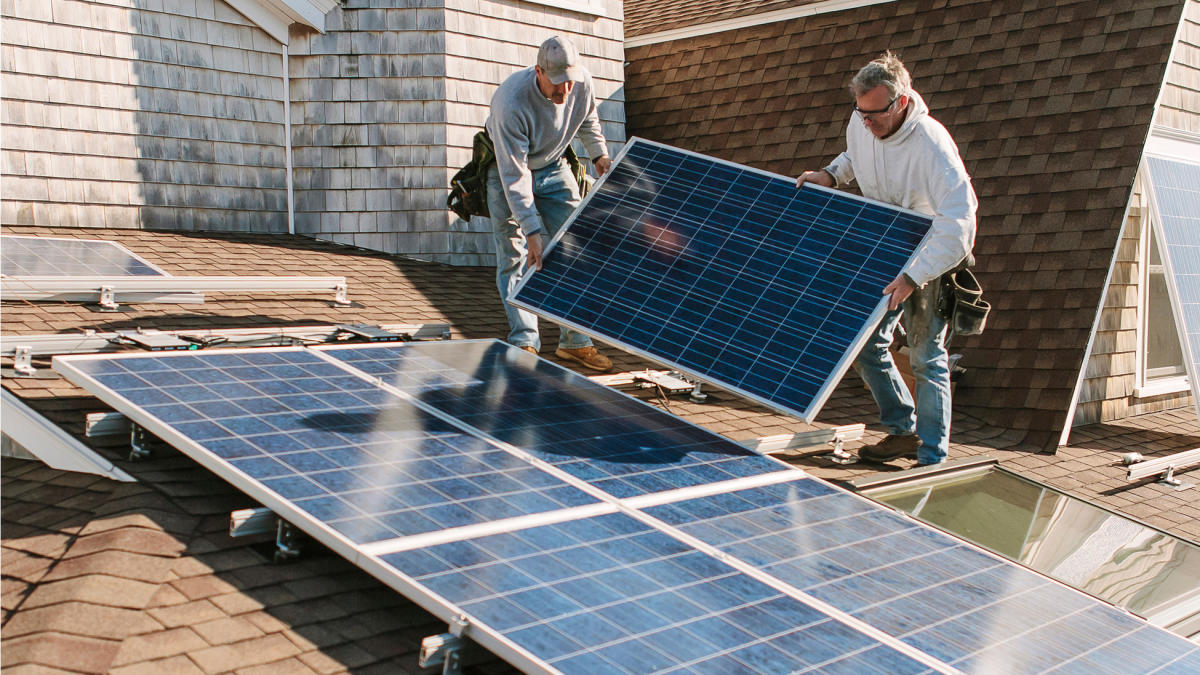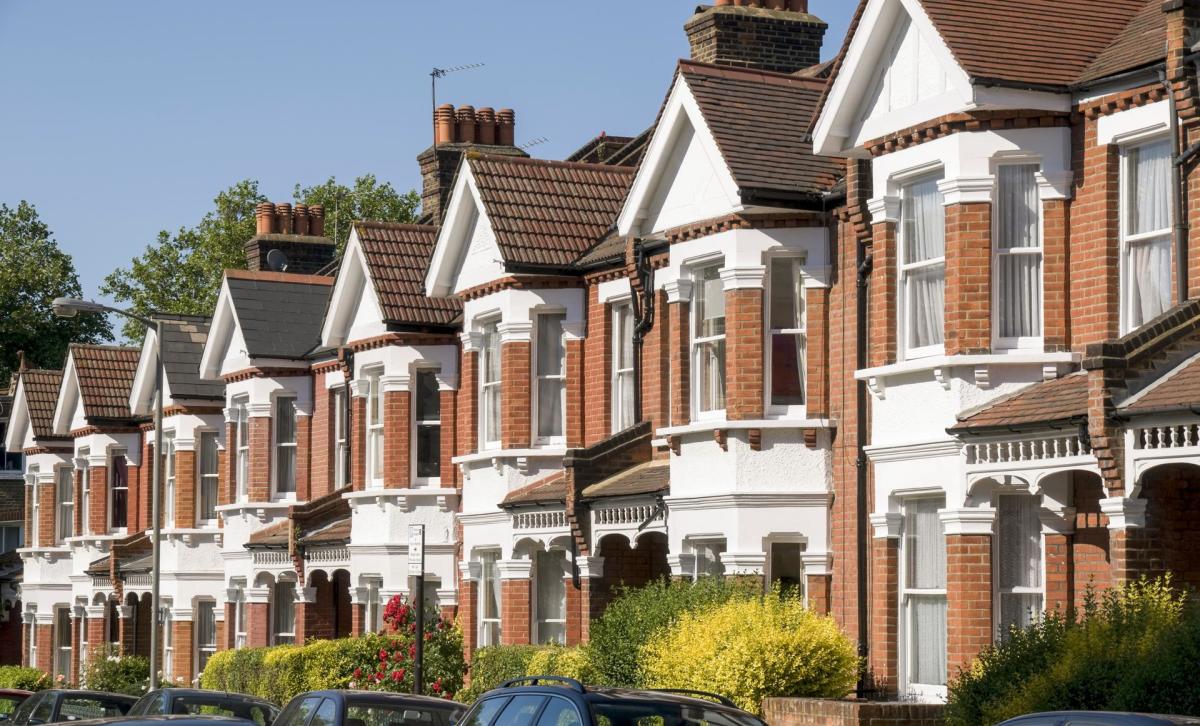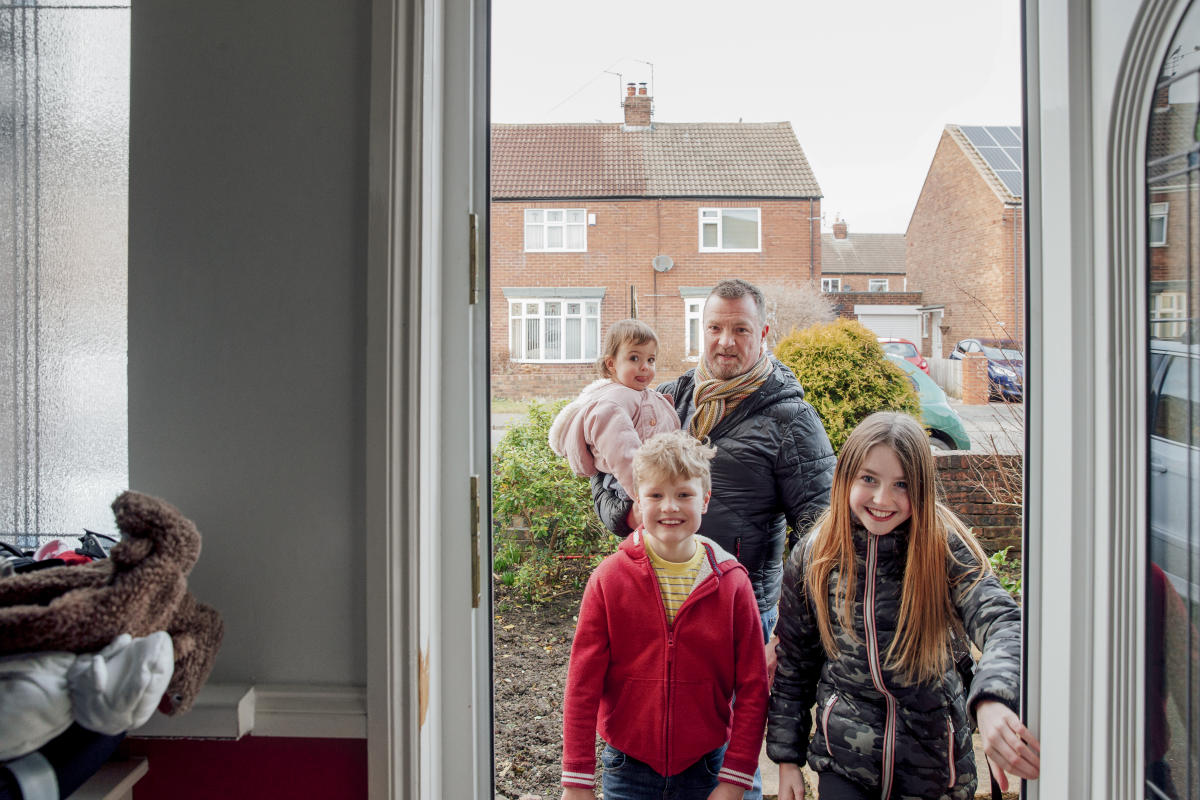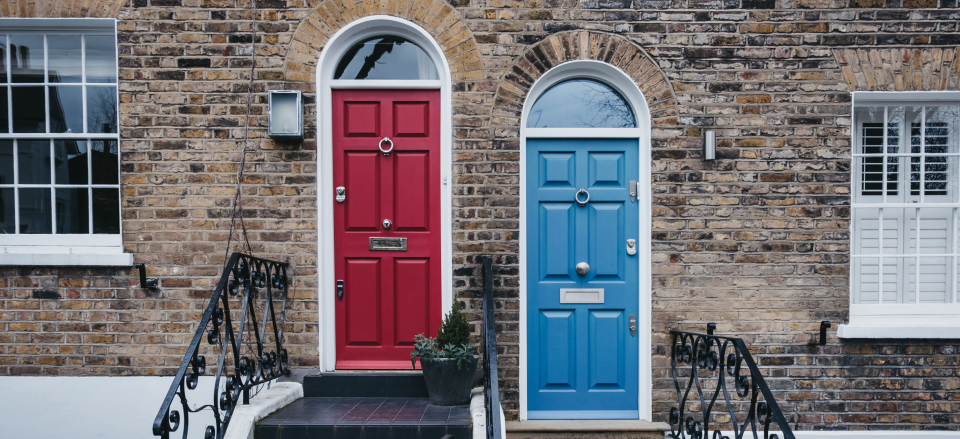Are solar panels worth the money?
Thinking about getting solar panels? They can be a great way to save on energy bills but there’s a lot to weigh up. Here’s our guide to solar panels and whether they’re worth the cost.
Want to reduce your carbon footprint and save on energy bills?
More people are choosing solar panels to do just that, with the number of projects rising by two thirds between 2019 and 2021, according to Barbour API.
Solar panels generate clean energy and reduce your reliance on the national grid. They can cut your carbon emissions by up to 1.6 tonnes a year and save you hundreds on your electricity bills.
But at an average cost of £6,500, they don’t come cheap. It could take you more than nine years to make your money back, depending on the type of system you go for.
Let’s take a look at the costs and considerations of solar panels and if they’re worth it in the long run.
1. How much do solar panels cost to install?
The average cost for a solar panel system comes in at around £6,500, so it’s definitely not a small investment.
That figure’s based on a 4.2kWp solar panel system across just under 30 square metres of your roof. It’s about the right size to cover the electricity of a three bedroom semi-detached house with four people living there.
As you’d expect, the cost of solar panels rises with the size of the system and the efficiency of the panels.
A smaller 3kWp system will bring the cost down to around £5,000, while a larger 6kWp one could set you back £11,000.
But the more you spend up front, the more you’re likely to save on energy costs.
If you live in a listed home or a conservation area, don’t forget to factor in the cost of planning permission.
2. How much money can you save with solar panels?
The numbers around solar panels are looking even better now that energy costs are rising again from October 2022.
When electricity costs 24p per kWh, solar panels could cut your electricity bill by £274 between October 2022 and April 2023 alone (The Eco Experts).
They reckon the average UK household with a new set of solar panels will now break even in 9.9 years.
But how much you can save varies, and it comes down to how efficient your system is, as well as how and when you use electricity in your home.
For example, you’ll save more money if you’re at home using your appliances during the day when the solar panels are active.
Work out what you could save with this solar energy calculator from the Energy Saving Trust.
3. How much value do solar panels add to your home?
With solar panel installations only really picking up in the last five years, it’s hard to put a figure on exactly how much value they’ll add to your home.
However, recent research has found that solar panels boost a home's value by 25% compared to similar properties in the same area (Admiral Money). That makes them the most value-adding home improvement in 2022.
And the same study found that people will pay 24% more for homes with an EPC rating of C or higher.
On top of this, our data shows that homes with an EPC rating of A or B are selling twice as fast as they were in early 2018, taking 28 days compared to the previous 56.
While all homes are selling faster now, homes rated F or G are only selling 15 days faster than in 2018 at 29 days.
And more buyers are choosing new-builds to meet their green priorities.
So it’s clear that energy efficiency is moving up on buyers’ lists of priorities.
Look at what you can do to improve your home's efficiency before – or at the same time as – getting solar panels. The overall energy efficiency of your home could have a big impact when you come to sell.
4. Do you need a solar battery as well?
The short answer is no – a solar battery is not essential. But having a battery means you can make the most of the solar energy your panels generate. They cost between £1,200 and £6,000.
A solar battery stores your solar energy. When it gets dark in the evening, you can keep using the power from your panels and you’re less likely to need to use electricity from the national grid.
If you do not have a battery, the national grid becomes your back-up. When it gets dark you’ll go back to paying for your electricity.
But without a battery, you can also send more electricity back into the national grid through the Smart Export Guarantee.
5. Can you solar charge an electric vehicle?
Solar panels and electric vehicles are a great combo if you want to go the extra mile for the environment.
You can use solar power to charge an electric vehicle and you just need an inverter unit, which converts solar power to electricity.
Keep in mind that you'll need a solar battery if you want to charge your car at night, otherwise you'll use electricity from the national grid.
6. How does the Smart Export Guarantee scheme work?
If you want to make your money back faster, have a look into the Smart Export Guarantee.
The government-backed scheme was introduced in 2020 and it sees suppliers pay you to send spare solar energy into the national grid.
Tariffs vary from 1.5p to 12p per kW, and can earn the average household between £80 to £110 a year.
Smart Export Guarantee scheme (Ofgem)
7. Which type of solar panel is best?
There are two main categories of solar panel: ones that generate electricity and ones that heat water.
Here’s a breakdown of the first kind, which are much more popular in the UK.
| Type of solar panel | Efficiency | Pros | Cons |
| Monocrystalline Solar Panels (Mono-SI) | ~20% | High efficiency rate; optimised for commercial use; high lifetime value | Expensive |
| Polycrystalline Solar Panels (p-Si) | ~15% | Lower price | Sensitive to high temperatures; lower lifespan and slightly less space efficiency |
| Thin-Film: Amorphous Silicon Solar Panels (A-SI) | ~7-10% | Relatively low costs; easy to produce and flexible | Shorter warranties and lifespan |
Greenmatch.co.uk
Mono-SI panels are made of high purity silicon, which means a high power output, less space needed and the longest life span at around 25 years.
P-Si panels are cheaper than Mono-SI panels. They’re a little less efficient and they don’t last quite as long.
But these two have a similar power output so get a recommendation from a solar panel installer. The type of solar panel that’s best for you will depend on your home, electricity usage, space and budget.
And keep in mind that although solar panels need very little maintenance, their efficiency does wane over time.
8. Is your roof suitable for solar panels?
Solar panels are most effective on certain homes, and it mainly comes down to the size and orientation of your roof.
For the most efficient solar panel system, you roof should have:
- enough space for a system that will generate the amount of electricity you use
- a south-facing aspect to get more sun and therefore generate more electricity (but east- and west-facing roofs are good enough)
- a pitch of between 10 and 60 degrees, although you can mount the panels at an angle to improve efficiency
- a sound structure to take the weight of the panels
- a bit of space in the loft or attic for the inverter, which is about the size of a microwave.
9. How to get solar panels fitted
If you’ve decided to go ahead with solar panels, you’ll need to find a qualified installer to fit them for you.
You can find qualified installers on the MCS website.
We also recommend choosing a company that’s registered with the Renewable Energy Consumer Code (RECC). This means they’ve committed to high consumer protection standards.
Costs vary between installers and products, so get quotes from at least three different installers.
Need help paying for solar panels? You might be able to get a loan through the Green Deal (GOV.UK).
10. Are solar panels worth it?
We’d say solar panels are worth the money if:
- you can afford them outright, and don’t mind waiting to see a return on your investment
- you have the roof space and orientation for a system that can cover most of your home’s electricity usage
- you use most of your electricity in the daytime – or you can get a solar battery to use solar power when it’s dark.
Solar panels are only ever going to be worth it if you can afford them. Be careful if you need to take out a loan as the interest repayments might be higher than your returns.
And while it’s important to think about the money, lots of people see the environmental impact as the key reason to invest in solar panels.
If you want to create clean energy, reduce your use of fossil fuels and cut your carbon emissions, solar panels are well worth the money.
Once they’re in, you’ll be having a positive impact on the environment and starting to make your money back.
Key takeaways
- Solar panels are a popular way to create clean energy, reduce use of fossil fuels and cut your carbon emissions by up to 1.6 tonnes a year
- The average 4.2kWp solar panel system costs £6,500 to install and can save you more than £500 a year on your energy bills
- You can use a solar battery to store your extra power or sell spare electricity to the national grid through the Smart Export Guarantee
- New research shows solar panels are the most value-adding home improvement, and can add up to 25% to the value of your home
Interest rates increase to a 14-year high
Nearly two million homeowners face higher mortgage repayments after the Bank of England hikes rates by 0.5.%
The Bank of England has increased interest rates by 0.5% as it continues to battle high inflation.
The move leaves the Bank Rate at 2.25%, its highest level since 2008.
It was the seventh meeting in a row at which its Monetary Policy Committee has hiked the official cost of borrowing.
The change will add around £50 a month to repayments for someone with a £200,000 mortgage.
Around 850,000 people have a tracker mortgage, while 1.1 million are on their lender’s standard variable rate, both of which move up and down in line with the Bank Rate.
Homeowners with variable rate mortgages have now seen their monthly payments rise by more than £200 a month since December, adding to the pressure they face from spiralling energy and food prices.
The latest increase is also bad news for first-time buyers, as higher interest rates reduce the amount they can afford to borrow.
Our research found that the increase from a 2% mortgage rate to a 4% one means the average first-time buyer will need an addition £12,250 a year in income for repayments to remain affordable.
What happens next?
The Monetary Policy Committee (MPC) has now hiked interest rates by 2.15% since it first started to raise the cost of borrowing in December last year in a bid to combat high inflation.
Despite inflation dipping slightly to 9.9% in August, the MPC warned that it had not yet peaked.
It expects inflation, as measured by the Consumer Prices Index, to continue rising to reach a high of 11% in October.
It said the peak would be lower and come sooner than previously thought as a result of the energy price freeze introduced by Prime Minister Liz Truss.
But it warned that the energy price freeze, and other measures that are expected to be announced in tomorrow’s mini-Budget, would lead to inflation remaining higher for longer.
This suggests the MPC may have to increase the Bank Rate by more than previously expected.
Rather ominously, the MPC warned in the minutes accompanying its interest rate decision that it would “respond forcefully, as necessary” to get inflation back to its 2% target.
It is also worth noting that while five members of the MPC voted to raise the Bank Rate by 0.5%, three members wanted to go for a more aggressive 0.75% hike.
As a result, interest rates are widely expected to be increased again in the coming months.
Economists are now predicting that interest rates will rise to between 3% and 4% during the first half of next year.
There was further bad news for homeowners, as the MPC also warned that it expects economic growth to contract by 0.1% in the three months to the end of September, which combined with the contraction in growth seen during the previous three months, would mean the UK was in recession.
On the face it, a recession, combined with rising mortgage rates and living costs, suggest the housing market will start to slow sharply in the final part of this year.
But if the government announces a stamp duty cut in its mini-Budget, as predicted, this could lead to a pickup in demand, providing support for house prices.
What should I do now?
If you are sitting on your lenders standard variable rate (SVR), the rate you are automatically put on when your mortgage deal ends, you should remortgage without delay.
The average interest rate charged on SVR mortgages was already 5.4% before the latest interest rate hike, its highest level for more than a decade, and it is likely to increase further.
Although other mortgage rates have been on a steady upward trend since December, you could still save £136 a month by switching to a typical two-year fixed rate of 4.24%, based on a £200,000 mortgage.
Adrian Anderson, director of property finance specialists Anderson Harris, said:
“The message to mortgage borrowers is very simple – don’t wait, take action now as its likely the situation will get worse in the short term.
“This is a huge reality check. We are no longer living in a period of ultra-low interest rates with plenty of disposable income, our outgoings are increasing faster than our income and we are going to have to adjust quickly and get used to the new norm.”
If you are on a fixed rate deal the situation is less urgent, as your monthly repayments will stay the same for the length of your product term, usually two or five years.
But if you are close to the end of your product term, you should try to find a new mortgage as soon as possible.
Most lenders will allow you to ‘book’ a new rate between three and six months before your current one ends.
Those coming off fixed rate deals should brace themselves for a significant increase in monthly repayments.
The average interest rate charged on a two-year fixed rate mortgage has increased from 2.24% two years ago, to 4.24% now, meaning someone with a £200,000 mortgage would see a £217 rise in monthly payments.
Those coming to the end of a five-year fixed rate will have seen average rates rise from 2.77% when they last remortgaged, to 4.33% now, leading to a monthly jump of £171 in repayments.
The decision of whether to remortgage is more complex for people on tracker mortgages, which move up and down in line with changes to the Bank Rate, and those who have more than six months left on a fixed rate deal.
If you are in this situation, before deciding whether to exit your current deal early, it is important to find out if you would face any early redemption penalties.
You should also try to calculate whether it is worth switching to a new mortgage now, which will likely have a higher interest rate than your current one, or wait until it ends but accept that mortgage rates will likely have increased again by then.
See out guide Will mortgage rates keep rising and should I remortgage now? for more details.
How can I reduce my mortgage repayments?
If you are about to remortgage and are worried about the increase in repayments you might face, there are steps you can take to reduce them.
One of the easiest ways to lower your repayments is to borrow less. As a result, you may want to consider making a lump sum overpayment to reduce the size of your mortgage if you have the savings to do so.
Alternatively, you can cut your monthly repayments by increasing your mortgage term.
For example, monthly repayments on a £200,000 mortgage on a fixed rate of 4.24% would be £1,252 if the mortgage was being repaid over 20 years.
But monthly repayments would fall to £992 if the term was increased to 30 years, and to £922 if it was being repaid over 35 years, although doing so would mean you paid more in interest over the entire life of your mortgage.
It is also worth remembering that although interest rates have increased, the value of your home is also likely to have gone up since you last remortgaged.
As a result, you will be borrowing a lower proportion of your property’s value than previously, known as the loan-to-value (LTV) ratio.
Lenders offer their most competitive rates to people with lower LTVs, so you may now qualify for a better rate than previously.
What can I do if I’m already struggling with my mortgage?
If you are already struggling to keep up with your mortgage repayments or think you may do so in the near future, it is important to contact your lender as soon as possible.
There are a number of steps lenders can take to help you, including granting you a temporary payment holiday or putting you on to an interest-only mortgage for a short time.
But options become much more limited if you have already missed a payment.
Key takeaways
- The Bank of England has increased interest rates by 0.5% to 2.25% as it continues to battle high inflation
- The change will add around £50 a month to repayments for someone with a £200,000 mortgage
- Around 850,000 people with a tracker mortgage and 1.1 million on their lender’s standard variable rate will be affected
Three-quarters of landlords are helping renters with cost-of-living squeeze
One in four landlords have frozen rents, while 22% have offered a payment holiday.
Three-quarters of private sector landlords have taken steps to help renters cope with the cost-of-living squeeze.
One in four landlords have frozen the level of rent they charge, while 22% have offered renters a payment holiday, according to research by bank Shawbrook.
Meanwhile, one in five landlords have reduced their rent, and 19% have offered to include the cost of bills in rent.
In the face of soaring energy costs, 26% of landlords are also taking steps to make their properties more energy efficient, such as improving insulation, installing double glazing or putting in a new boiler.
Emma Cox, managing director of real estate at Shawbrook, said: “In order to have a fair and sustainable rental market, it’s vital that landlords are open to supporting their tenants through hard times.
"Reducing rents or offering payment holidays will help tenants during the worst of the crisis and get them back on their feet.”
The findings come as our latest rental market report found that renters were looking for smaller homes to combat the cost-of-living squeeze, with two-bedroom apartments becoming more popular than three-bedroom family homes.
It also found that average rents for new lets had increased by £115 per calendar month during the past year.
Why is this happening?
With inflation, which measures the rate at which the cost of goods and services are increasing, currently running at a 40-year high, many people are struggling to cover all of their bills.
The Shawbrook study found that 85% of people living in the private rented sector had already made lifestyle changes to cope with the higher cost of living.
Many landlords recognise the pressure high inflation is putting on renters.
At the same time, it is often cheaper for them to freeze rent or offer a payment holiday, rather than face the costs and void periods associated with finding new renters.
What should I do if I’m struggling to pay my rent?
If you are struggling to pay your rent, you should contact your landlord as soon as possible to talk to them about the problem.
The research found that 14% of landlords who had not made any changes to their rent in response to the cost-of-living squeeze, would be prepared to do so if their renters were facing financial difficulties.
You are more likely to be successful if you suggest a plan to your landlord, such as paying a reduced rent for a set period of time, before resuming full payments.
What’s the background?
The Scottish Government recently announced that rents in both the public and private sector would be frozen until March 2023 as part of a package of measures to help people cope with increases to the cost of living.
It is also introducing a moratorium on evictions, meaning landlords will not be able to force renters to leave their homes, even if they fall behind with their rent.
Campaigners are calling for a similar rent freeze and eviction ban to be introduced for renters in other parts of the UK.
Meanwhile, the UK government has launched a consultation on introducing a cap on rent increases for people living in social housing, such as council and housing association homes.
The cap would be set at 3%, 5% or 7% from 1 April 2023 to 31 March 2024.
It has also included measures to protect renters from unfair rent increases and ban no fault evictions in the Renters Reform Bill, which will be introduced during the current parliamentary session.
Key takeaways
- Three-quarters of private sector landlords have taken steps to help renters cope with the rising cost of living
- Landlords are freezing rent, offering payment holidays and some are including the cost of bills in the rent
- Landlords are also taking steps to make their properties more energy efficient, such as improving insulation, installing double glazing or putting in a new boiler
Will there be a housing crash? Here’s what the data says
Spoiler alert: no, we don’t think there’s a housing crash coming. Let’s take a look at why the UK market is on track to avoid any major falls in house prices.
The housing market’s slowing down with fewer sales and slower house price growth.
But the housing market remains resilient despite economic uncertainty.
And we don’t see a housing crash on the horizon.
Why not?
Well, a huge amount of change since the Covid-19 pandemic has opened up the housing landscape in the UK.
It’s given us greater choice over where we live, highlighted our relationships with our homes, and altered our reasons for moving.
And the housing market’s in a very different position to the last time we saw house prices fall, after the global financial crisis of 2008.
Let’s take a look at what’s changed in the last few years, and why it means there won’t be a housing crash.
House prices aren’t as overvalued as they were in previous economic cycles
“House prices tend to fall when they get too high and out of kilter with incomes,” says- Executive Director.
“In the past, this has gone hand in hand with more relaxed mortgage lending.
“In 2007, more than a third of buyers taking out a mortgage didn’t prove their income to the bank. And almost a fifth were getting mortgages when they had small deposits of less than 10%.
“This led to house prices shooting up. Then, when mortgages dried up and the economy went into recession, prices fell back.
“The difference now is that there are much tougher rules to get a mortgage.
“You must prove a lot more about your income and outgoings. People usually have much more than 10% deposits so they are less vulnerable to possible negative equity.
“In short, we don’t have the scale of over-valuation of housing that we’ve seen before.
“This puts the market in a much better position to weather high mortgage rates and the increased cost of living.
“The housing market is not immune from these pressures and some will already be feeling the squeeze. But the likelihood of big price falls is much lower than in the past.”
House price growth has spread across the country
House price growth has spread around the country.
It’s no longer London and the South East that are tracking the biggest house price gains.
Instead, we’ve got the South West, Wales and the Midlands seeing the biggest house price growth.
With higher demand in new areas, the value of housing has started evening up across the country.
And when you’ve seen your house price rise, it’s another incentive to sell. Many people want to release equity or take the chance to upgrade their home.
More people want to move because of the pandemic
In a recent survey, we found that 22% of people were more keen to move house since the pandemic. Only 6% were more keen to stay put.
Of existing homeowners, 19% were eager to move because of the pandemic.
Those figures might not sound very high.
But when only 4% to 6% of owner-occupiers move house each year, it’s a massive proportion.
Was this just a short-lived, post-lockdown thing?
Nope.
We asked consumers the same question in 2022. And for those who want to move home, they’re even more certain it’s the right choice.
“The data suggests that attitudinal changes have matured,” says Richard. “They’re both more considered and more embedded within households.
“And when you have buyers with their mind set on a move, the market will keep moving too.”
Thinking all these committed buyers have already made a move?
Only 1 in 17 privately-owned homes changed hands in 2021. That means plenty of people who want to move and haven’t yet taken the plunge.
Hybrid working is here to stay
In February 2022, 42% of people plan to work mostly from home, according to the Office for National Statistics. That’s an increase from 30% in April 2021.
That’s around five million more workers who are now able to work from home when they want, and a total of 9.7 million people.
“We’ve seen a strong trend between home working and the desire to move home,” says Richard.
“Our consumer survey found that home workers are five times more eager to move than those with more traditional working patterns.”
54% of those who expected to work from home more said they were more eager to move, compared with 13% who expected to do less working from home in future.
Working from home patterns have been a major contributor to the demand to move home in the last two years. We expect this influence to continue in the years ahead.
First time buyers are more motivated to get on the ladder
The working from home trend has granted a huge amount of opportunity for first time buyers.
“In our survey, renters were the most keen to move house out of anyone” says Richard.
“25% of renters said they were more eager to move because of the pandemic.
“With less of a need to live close to the office, first time buyers can look further afield for their home.”
We’ve seen a marked increase in the radius that first time buyers are searching in since the pandemic.
“A first time buyer in London now considers homes in an area 33% bigger than pre-pandemic,” says Richard.
“And first time buyers outside of London stretch their search by a further 20% since the pandemic.”
“This shows that many first time buyers would rather get on the ladder now in a cheaper area using their current savings, than wait until they can afford a more expensive area.”
We’re still keen to swap city life for country living
It’s been one of the biggest talking points about the housing market since the pandemic.
That we all want to switch the city for a slower pace and more space.
And our research shows this trend is even more pronounced a couple of years on.
“Back in July 2021, people living in major cities were far more likely to want to move house (36%) than those in rural areas (3%),” says Richard.
“Fast forward to spring 2022, and 44% of city dwellers want to move to a more rural location.”
“Interestingly, more rural homeowners fancy a move this year, too (8%).”
“This is typically older homeowners looking to downsize. The influx of demand to rural areas has created more opportunities to relocate closer to family or take equity from their current home.”
More people are retiring
Almost half a million older workers have left the labour market since the pandemic.
A huge 63% of adults aged 50 to 70 left their job sooner than expected, according to the Office for National Statistics.
Leaving work to retire was the most commonly reported reason (47%). But 15% of retirees said they left because of the Covid-19 pandemic, and 13% cited illness or disability.
Retirement is a common trigger for selling your home.
You might want to be closer to family and friends. Some are looking to embrace a new lifestyle or indulge in a passion, while others want to downsize and release some equity.
There may be other practical reasons for a move in retirement, like the need for good public transport or healthcare nearby.
With 75% of older households (65+) owning their home outright (GOV.UK), this group has the means to make a move that suits their lifestyle. They’re keeping momentum in the market by offering homes for sale while also buying a new place.
Rising mortgage rates won’t hit existing homeowners too hard - but it will prompt some to move
Half of all homeowners have a mortgage, and the rest own their homes outright.
Of homeowners with mortgages, 90% are on fixed rate deals for up to 5 years. Many are on low rates of sub 2%.
So most homeowners with mortgages will be unaffected by interest rate increases due to their fixed rate.
And if they got their mortgage post-2015, they will have had to prove they can afford a mortgage rate of up to 7%. This means many homeowners will be able to absorb additional cost pressures on their budget.
Rising interest rates can also prompt some savvy homeowners to make a move. If they’re coming to the end of their fixed term, a move could help them lock in a rate they might not see again for several years.
With most mortgage offers lasting just six months, this impact will dissipate soon. But we expect it to be one factor that keeps the market buoyant in late 2022.
Key takeaways
- House prices aren’t as overvalued as they were in previous economic cycles
- Value has spread across the country, giving more people the ability and motivation to move
- More people are working from home, retiring and reevaluating their lifestyle, which all prompt sales and purchases
- Nearly a quarter of people said they want to move house since the pandemic, but only 1 in 17 privately-owned homes changed hands in 2021
Will mortgage rates keep rising and should I remortgage now?
The number of deals available has also fallen but it is still worth remortgaging if you are coming to the end of your deal.
Mortgage rates rose for the 11th month in a row in September and the level of choice fell as the market adjusts to higher interest rates.
The average cost of a two-year fixed rate mortgage reached a nine-and-a-half-year high of 4.24% in September, an increase of 1.9% since December last year.
The typical cost of a five-year fixed rate mortgage also rose to 4.33%, 1.69% more than in December and the highest level since November 2012, according to financial information group Moneyfacts.
Meanwhile, lenders have withdrawn more than 500 mortgage products during the past month, leaving 3,890 different deals for borrowers to choose from, the lowest level since April 2021 and down from more than 5,300 deals at the beginning of December.
The number of different mortgages available fell for all types of borrower, ranging from first-time buyers to those with large equity stakes in their property.
But there was some good news for potential borrowers, with the average amount of time a mortgage is available for before lenders withdraw it increasing from a record low of 17 days in August to 28 days this month.
Why is this happening?
The rise in mortgage rates reflects increases to the Bank of England base rate.
The Bank’s Monetary Policy Committee has hiked the base rate by 1.65% since December last year, as it tries to control inflation.
These increases make it more expensive for lenders to borrow money on the money markets, which is reflected in higher mortgage rates for customers.
Should I still remortgage?
Despite the increase in mortgage rates seen since December last year, it is still definitely worth remortgaging if you are coming to the end of your current deal.
The average standard variable rate – the rate that lenders put you on if you do not remortgage – is currently 5.4%, the highest level since December 2008.
The rate has now increased for nine months in a row, rising by 0.23% in August, the biggest monthly jump since Moneyfacts first started keeping records in December 2007.
And it is expected to continue rising, as standard variable rates typically move up and down in line with changes to the base rate.
Although interest on the average two-year fixed rate mortgage has now reached 4.24%, homeowners with a £200,000 mortgage could still save £136 a month by remortgaging, rather than sitting on their lender’s standard variable rate, even before future interest rate rises are factored in.
Will interest rates rise further?
The short answer is yes. But it is more difficult to predict exactly how much further they will increase by.
The Bank of England is currently increasing interest rates in a bid to bring down inflation.
Economists had previously predicted that inflation would not peak until early 2023, with some predicting it could get as high as 22%.
But following Prime Minister Liz Truss’ energy price freeze announcement, inflation is now expected to peak earlier in November this year and at a lower level of around 11%.
That said, by putting more money back into consumers’ pockets, economists think the energy price freeze will lead to inflation remaining elevated for longer.
As a result, interest rates are also likely to have to remain higher for longer.
Overall, economists are predicting the Bank of England will have to increase the base rate to between 3% and 4% by the middle of next year to get inflation back under control.
That would mean interest rates increasing by between 1.25% and 2.25% from their current level.
Which mortgages are best value?
Deciding what type of mortgage to opt for will depend a lot on your personal circumstances.
At an average of 4.24%, two-year fixed rate mortgages currently look expensive compared with five-year fixed rate ones which average 4.33%.
The premium borrowers have to pay for the security of fixing for five years has been narrowing since December and now stands at just 0.9%.
Meanwhile, the typical interest rate charged on a 10-year fixed rate mortgage is the same as that for a five-year one at 4.33%.
But before opting for a longer-term fixed it is important to remember that what looks like a competitive mortgage rate now, may not look such good value in three or four-years’ time.
The current level of global uncertainty makes it difficult to judge how long interest rates will need to remain high for, but with the UK expected to go into recession, they are not expected to remain high for too long.
It is also important to think about your own personal circumstances, as if you need to exit a five or 10-year fixed rate mortgage early, you are likely to have to pay an early redemption penalty.
These vary according to how long you have left on your mortgage deal. For example, if you have three years left on a five-year fixed rate mortgage, you may have to pay a fee equivalent to 3% of your outstanding mortgage debt.
What about tracker mortgages?
The average rate on a tracker mortgage is currently much lower than that on fixed rate ones, with interest on a two-year deal averaging 3.33%.
But while this may look good value compared with fixed rate mortgages, remember that while the interest you are charged on a fixed rate deal stays the same for the product term, the rate on a tracker one moves up and down in line with changes to the base rate.
As a result, if the base rate increases to 3%, the rate on a two-year tracker mortgage would increase to 4.58%, while if the base rate goes up to 4%, the tracker rate would rise to 5.58%.
How much will my mortgage repayments increase by?
If you are coming to the end of a two-year fixed rate mortgage, the cost of another two-year fixed rate deal is likely to be around 2% higher than when you last remortgaged.
The average interest rate charged on a two-year fixed rate mortgage was 2.24% in September 2020, compared with 4.24% now.
This means someone with a £200,000 mortgage being repaid over 25 years, will see their monthly repayments increase by just over £200 a month.
Of course, if you have a smaller mortgage, the impact will be less, with repayments on a £100,000 loan increasing by around £100 a month in the example above.
What should I do if my mortgage deal still has a few months left?
Deciding what you should do is a bit tricker if your mortgage deal still has a few months left to run.
The first thing you need to do is find out if you would have to pay any fees for exiting you current product early.
If you do and these are high, you may be better off staying where you are.
Next, take a look at what your monthly repayments are now, and what they would be if you remortgaged to one of the products that is available today.
If you are on a very competitive rate, it might work out cheaper for you to stay where you are until the deal ends before remortgaging, even if interest rates have increased by then.
For example, let’s say you currently have seven months left on a two-year fix for a £200,000 mortgage at a rate of 1.5%. Your currently monthly repayments would be £800 a month or £5,600 over seven months.
If you remortgaged to the average two-year fixed rate of 4.24%, your monthly repayments would be £1,095 a month or £7,665 over seven months.
You can ‘book’ a new mortgage deal between three and six months before your current one ends.
As a result, interest rates may only have increased by 0.5% or 0.75% before you are able to secure a new deal.
If interest rates rose by 0.5%, and this was passed on by lenders, your repayments would be £56 a month more than if you remortgaged now.
Under this scenario, you would save £2,065 by delaying remortgaging for seven months, while you would pay a total of £1,344 more in repayments over a two-year mortgage term if interest rates had risen by a further 0.5% by the time you remortgaged, meaning you would be better off delaying.
If interest rates had risen by 0.75% before you remortgaged, it would cost you an additional £86 a month or £2,064 in repayments over two years, meaning you would be in broadly the same position as if you had remortgaged before your term ended, assuming you did not incur any early exist penalties.
Unfortunately, no-one knows exactly what will happen to interest rates in the months ahead, and deciding whether or not to remortgage early will depend on the rate you are paying now.
If you are unsure about what you should do, it may be worth seeking the advice of a mortgage broker.
Key takeaways
- Mortgage rates rose for the 11th month in a row in September and the level of choice fell as the market adjusts to higher interest rates
- The average amount of time a mortgage is available before lenders withdraw it has increased from a record low of 17 days in August to 28 days today
- With the Bank of England base rate expected to rise to 3% or 4%, homeowners coming to the end of a deal should remortgage now
Renters look for smaller homes in cost of living squeeze
Demand for two-bed apartments on the up as renters try to combat rising rent and energy costs.
As the cost of living squeeze looms large, rising rents and energy bills are pushing renters to look for smaller homes in a bid to reduce outgoings.
Our latest data on rental demand shows that renters are shifting their focus from three-bed houses to two-bed flats. And that trend is growing.
With the gas needed to warm a purpose-built flat working out around 40% less than that needed to warm a three-bed family terraced home, or 25% less with a flat conversion, the savings are set to be substantial.
A one-bed home requires less than half the gas that’s needed for a three-bed home.
And D and E rated homes need 25% and 48% more gas to run compared to a C rated home.
The decline in the number of renters looking for two- and three-bed houses in the last year has been significant, as the pendulum of demand swings towards one- and two-bed flats.
And our data suggests the appeal of apartments and energy-efficient homes will only grow as we head into 2023.
The cost of renting is also having an impact on where renters are choosing to live.
Outside of London, the current difference in rents charged for a two-bed flat and a three-bed house is £105 per month.
This translates into £1260 per year in rent, so big savings can be made by moving into smaller apartments.
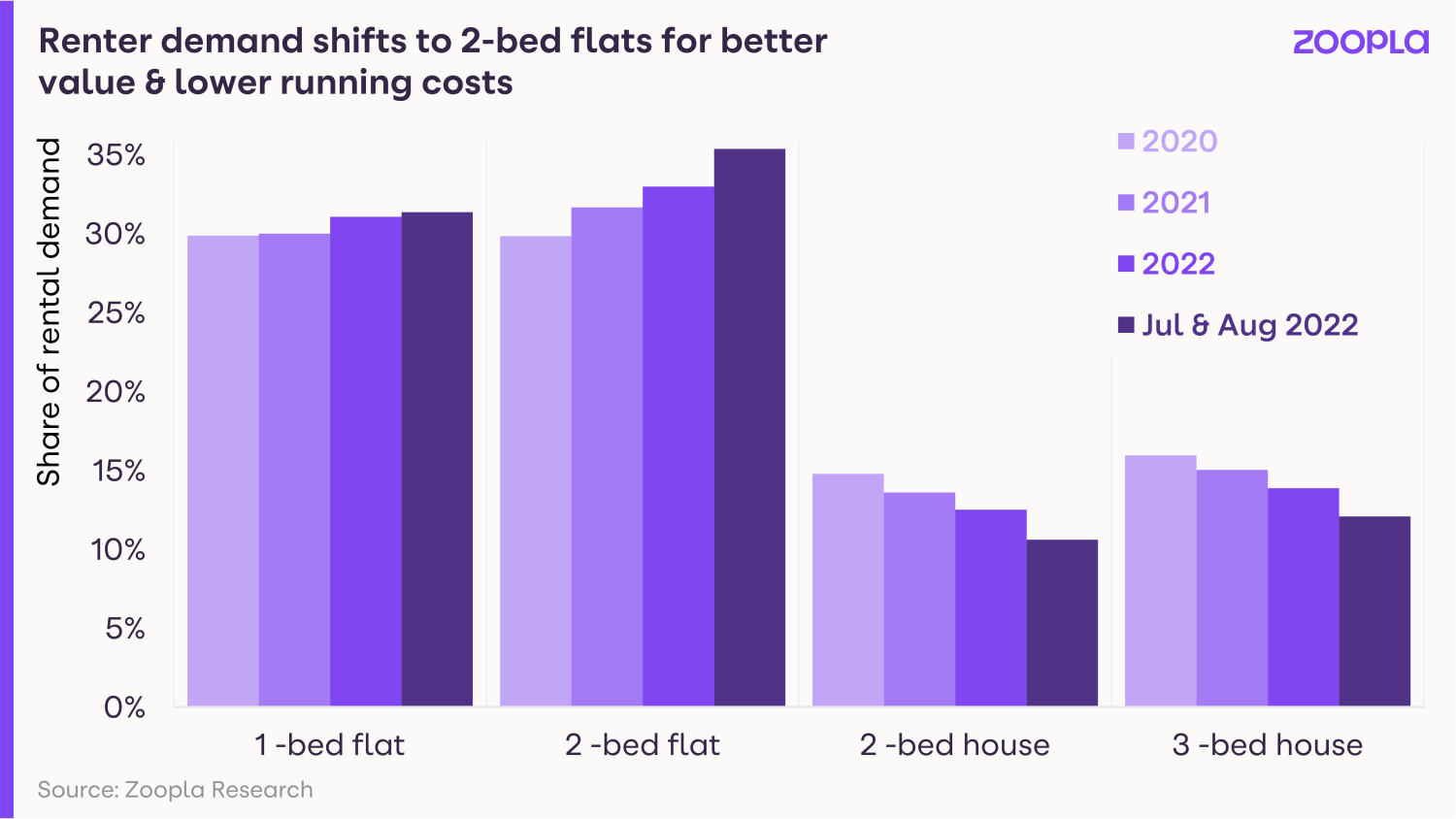
Yet conversely, despite all of these cost of living headwinds, a chronic undersupply of rental properties available on the market means rents will continue to grow at above average rates into 2023.
Massive supply shortage drives up rents
The average rent has gone up by £115 per month since September last year to £1,051 a month.
The rise is outpacing earnings growth across the country and basically boils down to a major shortage of available homes.
Right now, rental home stock levels are sitting at around half the numbers seen on the market in the past five years, so there’s a lot less choice out there for renters.
Many renters are also deciding to stay put with their current landlords to avoid future rent increases.
And from the landlords’ side, increasing taxes and regulations are causing many to sell up as letting a home becomes less affordable.
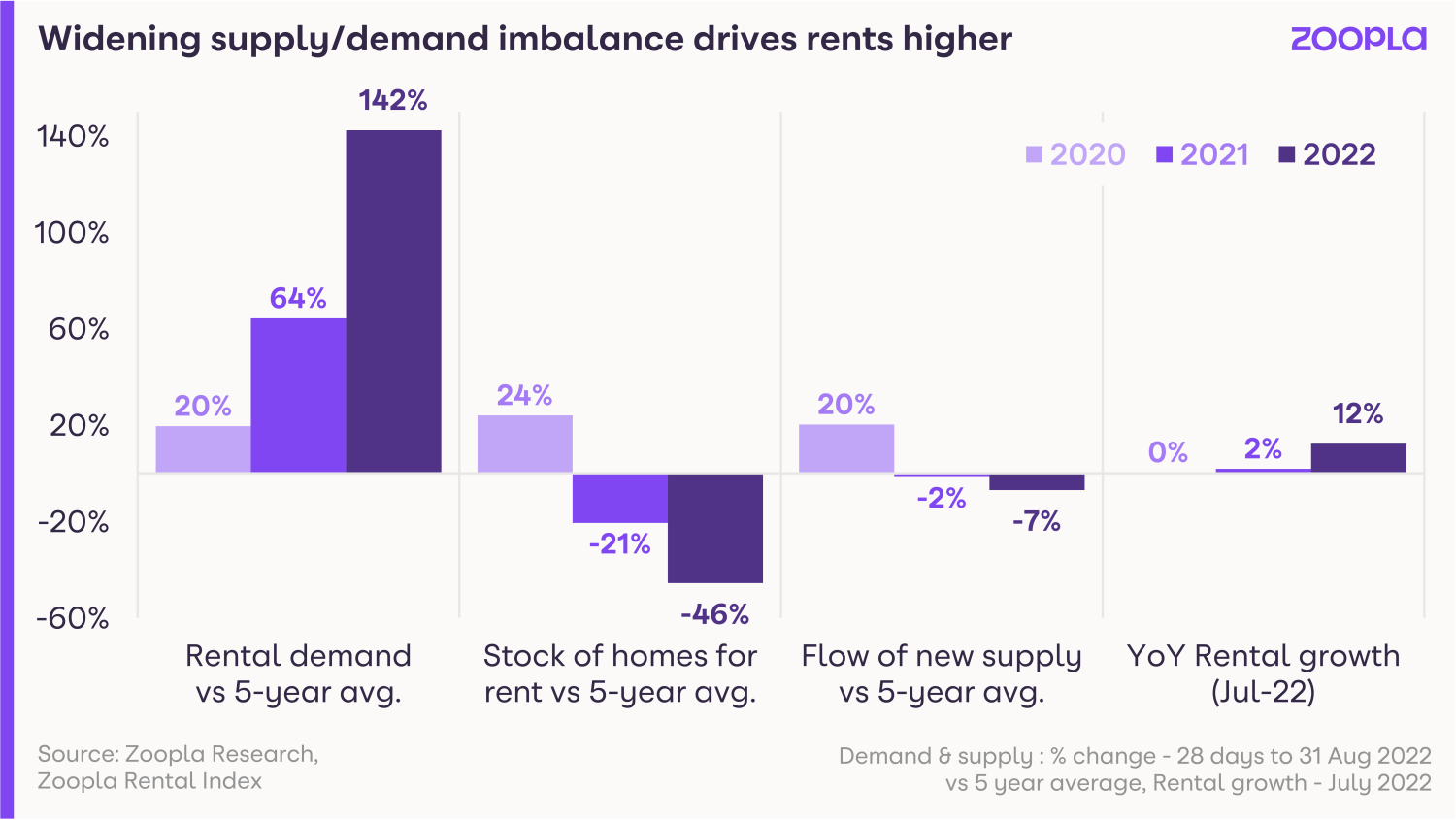
Hannah Gretton, Lettings Director at LSL’s Your Move and Reeds Rains brands says: “We are experiencing high levels of demand for rental properties with homes being snapped up within hours of hitting the market.
“With over 270 lettings branches nationwide, it's a picture that is reflected up and down the country with particular demand in urban areas.
“On average, we are seeing double figures of enquiries per property with a one-bedroom property in Manchester last week receiving over 100 requests to view, highlighting just how busy our branches are and the challenges renters face when it comes to finding an appropriate property."
Where are rents rising fastest?
The capital has long been the most expensive place to rent a home and rents here have gone up by 18% on average in the last year.
However, rents did fall by 10% in London during lockdown, so these rent rises are coming up from a low base.
When compared directly with pre-pandemic levels, rents are actually up 7.8% in London. But in the rest of the UK, they’ve risen by 13% on average.
Renters make a return to the cities
Strong employment growth in cities - and the growth in high quality, purpose built build-to-rent homes around the UK - is attracting renters into urban areas.
Energy efficient new-build homes are currently proving to be a big pull, and most new developments tend to be around city centres.
In fact, build-to-rent developments, featuring stylish apartments with luxury on-site facilities, are currently driving the growth of rental housing stock in the UK.
More cost-effective to heat, thanks to brand new energy-efficient boilers, double or triple glazing and low energy lighting, the appeal of new-build homes is growing fast.
However, fierce competition for homes is also leading rents to increase by 10.5% in urban areas, compared with 8.5% in the countryside.
How much higher can rents go?
The private rental market caters for a range of households on low and high incomes, with a quarter of tenants receiving housing benefit.
And while rental affordability varies according to location and income, in the latest English Housing Survey from 2020 to 2021, three-quarters of private renters said they found rental payments very or fairly easy to meet.
Conversely 25% found them fairly or very difficult to pay.
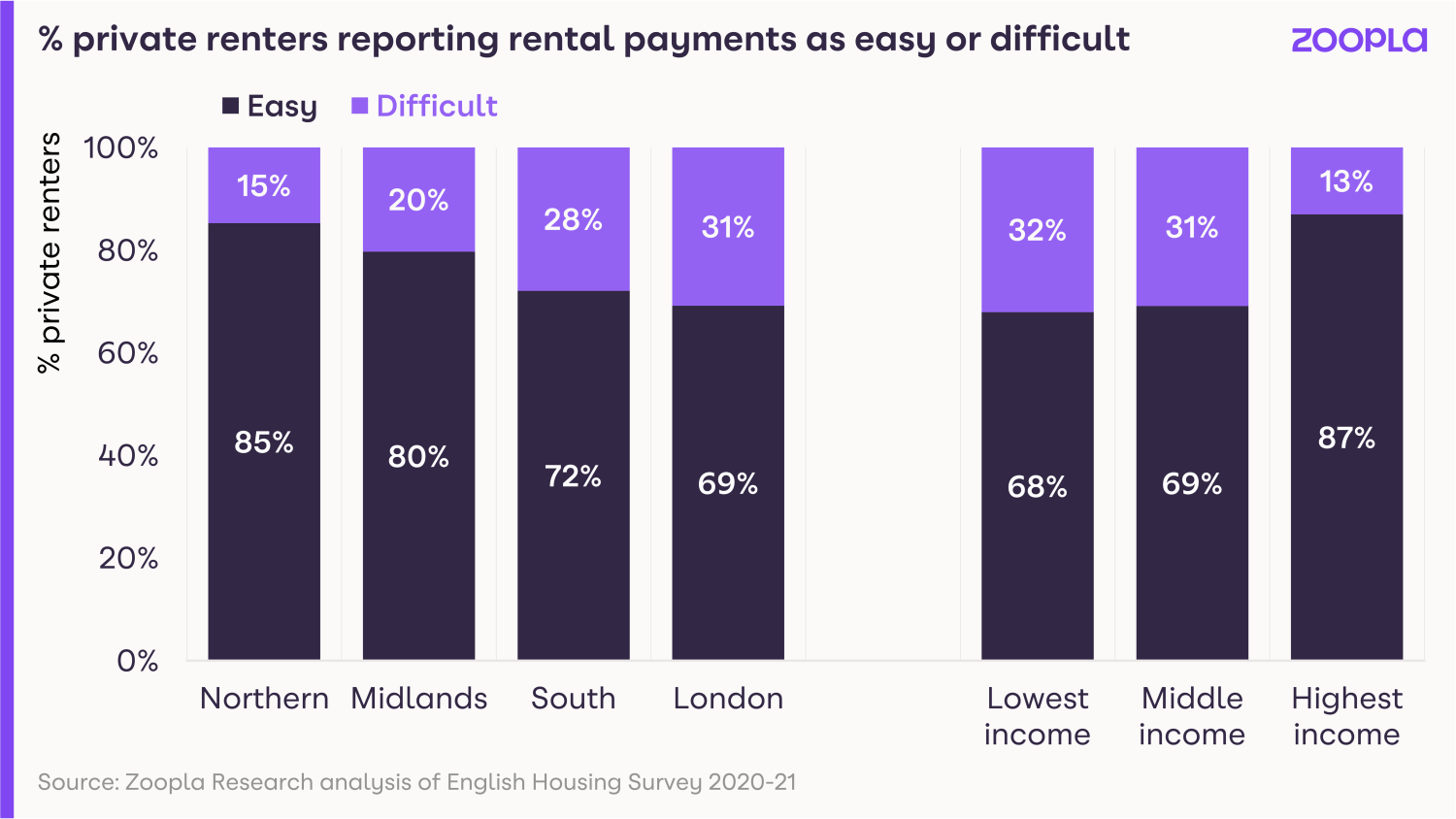
In the North and the Midlands, where rents tend to be cheaper, more tenants found their rent easy to pay. However in the south, more tenants reported that their rent was difficult to pay.
The question of how much higher rents can go will depend on how much headroom renters have to pay more rent.
And while the pace of rent increases is beginning to plateau, our data on rental affordability suggests there is still further headroom for above-average growth in the less expensive areas of the UK.
Apartment rents rising faster at the top end of the market
Asking rents for two-bed flats are rising faster in the top 25% of the market, with growth lagging across the bottom 25% of the market (where demand is more price sensitive).
For three-bed houses, there is less of a difference, but in many regions, the asking rents in the more affordable segments are rising faster.
However, as rented family homes become less attainable, demand for two-bedroom apartments is climbing as renters seek homes that are better value for money.
Rents for non-movers rising at a much slower pace
The average renter moves every four years, so our data reflects rent prices on new lets for around 25% of the market.
However, the Office for National Statistics’ rental index shows rental increases across the board, for movers and non-movers.
It shows current rents across all rented homes are 3.7% higher than they were in July 2021.
However, those moving to a new rented property will find the cost of renting 12.3% higher - as rents for new lets are reflecting the current lack of supply amid high demand across the country.
What’s going to happen to rents in the rest of 2022 and into 2023?
There is no real prospect of a significantly improved rental supply in the near term, as private landlords continue to sell off homes and renters stay put for longer.
The imbalance in supply and demand is here to stay, and rents will continue to rise at above-average levels into 2023 across the more affordable markets.
There is headroom for some renters to pay more - especially outside London and the South East - where rents are already high.
We expect the headline rental growth to slow over the rest of 2022 and into 2023 - but it won’t happen quickly.
Executive Director says: “Rents have surged ahead over the last year but there are signs that the pace of growth is peaking and set to slow into 2023.
“Renters are responding and looking for smaller, better value for money homes to rent with an eye on energy costs as much as rental levels.
“What the rental market needs to combat these challenges is more new homes for rent.
“Greater regulation has discouraged some landlords from investing and more are exiting, meaning the rental market has stopped growing since 2016.
“There is a risk that more regulation to improve standards or potential new measures to dampen rental growth, as proposed in Scotland, may compound the supply problem which is pushing rents up in the first place.
Key takeaways
- Renters are choosing two-bed apartments over three-bed family homes to reduce outgoings as the cost of living rises
- Rents on new lets have gone up £115 per calendar month compared with this time last year, rising faster than wages
- In a market where demand is massively outstripping supply, rents are likely to keep going up into 2023
Energy price freeze announced
The average household will see their energy bills frozen at £2,500 a year until October 2024.
Energy prices for households will be frozen until October 2024, the government announced today.
The move, under which the combined gas and electricity bill for the typical household will be held at £2,500 a year, will protect people from further spiralling energy costs.
The average household is currently paying £1,971 in energy bills, but that figure was set to soar to £3,459 from October 1, while analysts had warned it could rise to more than £5,000 from January.
Today’s announcement will save the typical household just under £1,000 a year, but energy bills will still be double the level they were at the beginning of 2022.
Those who heat their home using oil, as well as people living in Park Homes or on heat networks, will receive equivalent support.
The energy price freeze was welcomed by consumer groups, but some warned that many people were already facing fuel poverty when average annual bills were at a lower rate of £1,971.
What are the details?
Under the terms of the energy price freeze, the maximum amount power companies can charge customers per unit of energy used will be capped until October 2024.
As companies are currently paying significantly more than this level for power on the wholesale markets, the difference in price will be covered by the government.
While the average household will see their bill frozen at £2,500, the actual level of bills will vary from household to household depending on how much power they use, with some paying more than this amount and some paying less.
Consumers do not have to do anything to benefit from the price freeze, as it will be automatically passed on by their supplier.
It is estimated that the scheme will cost the government around £150 billion over the two years.
How will the price freeze impact the housing market?
Soaring energy prices as a result of the conflict in Ukraine have been a major factor in pushing inflation higher.
Inflation as measured by the Consumer Prices Index – which tracks the rate at which the cost of goods and services frequently bought by consumers are increasing – hit a new 40-year high of 10.1% in July.
The Bank of England has been aggressively hiking interest rates since the end of last year in a bid to bring down inflation, which it is supposed to keep at around 2%.
Before today, there had been warnings that inflation was set to rise to 13% by October, with some economists predicting it could hit 18% or even 22% next year if the government did not take steps to tackle the energy crisis.
Today’s news means inflation is likely to peak sooner than previously expected at around 11.5% in November.
It is also good news for the housing market.
Our latest House Price Index showed that demand was beginning to cool in the face of rising mortgage rates, the cost-of-living crisis and general economic uncertainty.
The energy price freeze will provide some relief to those worried about facing a sharp rise in their bills from October, helping to support demand.
But it is unlikely to be enough to reverse the current slowdown.
What should I do if I am struggling to pay my bills?
If you are already struggling to pay your energy bills or are worried you might run into difficulties, make sure you are claiming any support that is available to you.
A number of the major energy companies offer grants to help people falling behind with their fuel bills, including British Gas, which offers up to £1,500 for individuals and families who are in energy debt regardless of who their supplier is.
In March this year, the government announced that every household would have £400 cut from their energy bills, with low-income households, pensioners and people with disabilities receiving up to £800 off.
In addition, pensioners will receive an additional £300 Cost of Living Payment, while people with disabilities will receive £150.
Support is also available through the Household Support Fund and the Warm Home Discount Scheme.
If you do fall behind, it is important to contact your supplier as soon as possible. Ofgem has rules that they must help you if you can’t afford your energy bill, and they should work with you to create an affordable payment plan.
There are also a number of steps you can take to reduce your gas and electricity consumption, such as turning your thermostat down, taking shorter showers, draft-proofing your windows and doors, not using a tumble drier and turning off appliances left on standby mode.
Key takeaways
- Energy bills will be frozen at an average of £2,500 a year until October 2024
- The move will save the typical household just under £1,000 a year, but bills will still be double the level they were at the beginning of 2022
- Those who heat their home using oil, as well as people living in Park Homes or on heat networks, will receive equivalent support
As Scotland announces a freeze on rents, will the rest of the UK follow suit?
Renters in both the public and private sectors in Scotland will be protected from eviction as part of measures designed to help with the cost of living crisis.
Rents in Scotland are set to be frozen until March 2023 as part of a package of measures to help people cope with the cost of living crisis.
The emergency legislation will apply to renters in both the public and private sectors, the Scottish Government has announced.
It is also introducing a moratorium on evictions, meaning landlords will not be able to force renters to leave their homes, even if they fall behind with their rent.
The rent freeze will be accompanied by a new tenants’ rights campaign, as well as a one-stop website that will give people information on the benefits and support that is available if they are struggling to keep up with their bills.
Campaigners are calling for a similar rent freeze and eviction ban to be introduced for renters in other parts of the UK.
Generation Rent said: “Every renter deserves certainty that they won’t be hit with further costs.”
However, there are fears that introducing a cap on private rents could force more landlords out of the rental sector, worsening the situation for renters in a market where the supply of rental homes is already strained.
UK government proposes rent cap for social housing
The UK government recently launched a consultation on introducing a cap on rent increases for people living in social housing.
However, the proposals don't include the private sector.
It is proposing limiting any rent increases on council and housing association homes to 3%, 5% or 7% from 1 April 2023 to 31 March 2024.
It estimates the move would save social housing renters around £300 a year each.
The government regulates how much social housing rents can increase by each year.
But rises are set at the rate of inflation as measured by the Consumer Prices Index plus 1%, meaning social housing renters could face increases of 11% next year without intervention.
Government plans for the private rental sector
A separate consultation has also been launched on setting a minimum standard for homes in the private rented sector for the first time.
The Decent Homes Standard would require homes in the private rented sector to be kept in a good state of repair with efficient heating and suitable facilities, while being free from serious hazards, such as major damp or fire risks.
Executive Director of Research, Richard Donnell, says: "The UK has seen a greater focus on the taxation of landlords and regulations to improve standards of housing rather than controlling rents.
"UK landlords have some of the toughest tax treatments and the Rental Reform Bill in England will improve standards of homes but also increase costs further.
"Against this regulatory backdrop, talk of possible rent controls will simply push more to exit the sector worsening the supply problem pushing rents up in the first place.
"It is important policy makers focus on the supply side problems in the rented sector in addition to the level of rents as the two are inextricably linked.
"We need to ensure policies and regulations encourage as many decent landlords as possible to remain in the market, otherwise the market will not grow and will start to decline in size, pushing rents up further."
Why is this happening?
Inflation, which measures the rate at which the cost of things increases, is currently running at a 40-year high of 10.1%.
One of the biggest increases people face is soaring gas and electricity bills.
The average household will see their combined energy bill rise from £1,277 at the beginning of the year to £3,549 from October after the energy price cap was increased, with some forecasts suggesting it could hit £5,300 in January.
Announcing the measures, First Minister Nicola Sturgeon said the magnitude of action needed to help people cope with the rising cost of living was on a scale similar to the initial response to the Covid-19 pandemic.
Who does it affect?
The rent freeze and eviction ban apply to renters in both the public and private sector until at least 31 March 2023.
The emergency legislation will take effect immediately.
But it will only help people who rent a home in Scotland. Renters in England, Wales and Northern Ireland will need to wait to see if similar legislation is introduced.
Key takeaways
- Rents in Scotland are set to be frozen until at least March 2023 as part of a package of measures to help people cope with the cost of living crisis
- The freeze will apply to renters in both the public and private sector with immediate effect
- Campaigners are calling for the rest of the UK to follow suit
What can I do if I’m struggling to pay my mortgage?
With the cost of living rising, some homeowners may find themselves struggling to meet their monthly mortgage repayments. Here’s what to do if it's happening to you.
If you’re finding you can no longer afford your mortgage repayments, there are options out there that could help you through a difficult time.
Here’s what to do if you think this might be about to happen to you.
What should I do if I think I might miss a mortgage payment?
Contact your lender as soon as possible.
Lenders will always try to work with customers who are experiencing financial difficulties.
But you’re likely to have more options if you contact your lender before you’ve missed a payment.
As soon as you think you might have a problem, get in touch with your bank or building society straight away.
How should I contact my lender?
Check your lender’s website to see how they want you to get in touch if you are experiencing financial difficulties.
Some lenders have a special helpline for people in this situation.
Most lenders will offer a variety of ways in which you can contact them in this scenario, include call hotlines, email, online chats and mobile apps.
Don’t leave contacting your lender until the last minute, as they may be experiencing a high volume of calls.
If you find yourself facing long waiting times on hotlines, try contacting your lender by email or through their website instead.
Will I lose my home?
Losing your home is most people’s worst nightmare. So, it’s good to know that repossessing a property is usually a last resort for lenders.
Instead, they will work with you to try to find a way to make your mortgage repayments affordable.
Charles Roe, Director of Mortgages at UK Finance, says:
“Lenders stand ready to help customers who may be struggling with their payments.
“It is important that anyone experiencing financial difficulty gets in touch with their lender as soon as possible to discuss the best options for them.”
What do I need when I contact my lender?
The most important things you'll need are your mortgage details and account number, so your lender can look you up on their system.
It’s also a good idea to do a budget before you make the call, so you know exactly how much you have coming in and going out each month.
And look for any areas in which you can cut back on your expenses.
Having a clear idea of what you can afford will help you as you discuss a way forward with your lender.
Can I take a mortgage payment holiday?
During the early stages of the Covid-19 pandemic, lenders introduced a mortgage payment holiday scheme.
Under the scheme borrowers could defer their mortgage payments for up to six months.
Unfortunately, the scheme has now ended, and no new official scheme has replaced it.
But lenders are still granting mortgage payment holidays to borrowers on an individual basis.
These payment holidays are typically two to three months long.
Interest that's not paid during this period is added to the outstanding mortgage debt.
What are my options if I can’t pay my mortgage?
There are four main options if you're struggling to pay your mortgage.
The best option for you will depend on your individual circumstances.
1: Extend the length of your mortgage term
The mortgage term is the total period over which you repay your mortgage.
Spreading the debt out over a longer period of time will reduce your monthly payments.
If you’re struggling to afford your mortgage due to higher bills, increasing your mortgage term could be a good option.
Increasing the period over which you repay a £200,000 mortgage from 20 to 30 years would reduce your monthly repayments from £1,019 to £744.
This calculation is based on an interest rate of 2% and a repayment period of 25 years.
The advantage of this option is that you continue to repay your mortgage.
The downside is that by increasing the term, you’ll pay more in interest over the total period of your mortgage.
2: Change to an interest-only mortgage
Changing from a repayment mortgage to an interest-only one dramatically lowers your monthly payments.
Since you’ll only be paying the interest on your loan each month, rather than paying down the actual debt, it's a much cheaper option in the short term.
If you’re going through a temporary fall in income, moving to an interest-only mortgage may be a good option as it will significantly reduce your monthly repayments.
For example, if you have a £200,000 mortgage, switching to an interest-only loan will cut your repayments from £854 to just £333 per month.
This calculation is based on an interest rate of 2% and a repayment period of 25 years.
But your lender is only likely to want to do this for a limited period, as you won't be reducing the overall amount you owe.
You’ll also still need to find a way to repay your mortgage over the longer term.
3: Defer your mortgage repayments
You can defer your mortgage and interest payments for a short period of time, typically two to three months.
After this period, the payments you missed will be added to your monthly repayments until you've made them up.
This is often done over the course of one to two years.
4: Request a payment holiday
During a payment holiday, the interest you don’t pay during the holiday will be added to the overall amount that you owe.
A mortgage payment holiday may be a good option if you have seen a sharp drop in your income or been made redundant.
The holiday will give you breathing space of two to three months in which to get back on your feet.
But lenders are unlikely to offer you a holiday for longer than this.
They will also want to be confident that you'll be able to resume repayments once the holiday ends.
The payments you have missed will still need to be made up at a later stage.
If I take out any of these options, will I have to pay any fees or penalties?
No, lenders understand that if you are facing financial difficulties, the last thing you need is extra fees or penalties.
As a result, you won’t face any charges to change to a plan agreed with your lender.
But you may face penalties if you miss a mortgage payment without contacting your lender.
So be sure to keep them up to date with your circumstances.
Are these options open to everyone?
Lenders want to work with you to help you avoid losing your home.
They will try to find an option that works for you even if you've lost your job, or have a poor credit history.
That said, they'll want to feel confident that you can keep up with your repayments over the longer term.
They won't want you to get so far behind with your payments that you can't catch up with them.
Will it impact my credit score?
Unfortunately, taking out a mortgage payment holiday may impact your credit score.
This is nothing to do with mortgage lenders. Instead, credit reference agencies will spot that you have not made a monthly repayment that you were scheduled to make.
This may make it harder to borrow money over the short term. But there are steps you can take to improve your credit score once you get your finances back on track.
Key takeaways
- First things first, if you’re finding it hard to pay your mortgage, contact your lender. Don’t be afraid, lenders will work with you to find a solution
- Options may include a mortgage holiday, changing to an interest-only loan, or increasing your mortgage term
- If you think you might miss a payment, contact your lender as soon as possible before it happens, as they'll be in a better position to help
First-time buyers have just two months left to use the Help to Buy equity loan scheme
The government’s flagship initiative to help people get on to the property ladder will close to new applications on 31 October.
First-time buyers have just two months left to use the Help to Buy equity loan scheme before it closes to new applicants.
The flagship initiative to help people get on to the property ladder will stop accepting new applications at 6pm on 31 October, before closing completely on 31 March 2023.
The scheme enables people to purchase a new build property with just a 5% deposit. The government then tops this up with a 20% equity loan, rising to 40% in London, that is interest free for the first five years.
Since it was first launched in 2013, more than 350,000 people have used the Help to Buy equity loan to purchase a home.
What does the deadline mean?
Because the Help to Buy equity loan only applies to new build properties, the scheme effectively has two deadlines.
This is because new build properties are typically sold off plan and then have to be built.
As a result, the first deadline of 6pm on 31 October is the date by which you must apply to the Help to Buy equity loan scheme, having agreed to purchase a home off plan.
In practice, this means submitting your Property Information Form to your Help to Buy agent by this date.
The second deadline of 6pm on 31 March 2023 is the date by which you must have legally completed on your home, meaning you must have the keys and be able to move in.
If you don’t complete by this date, you will not be eligible for the equity loan.
There is also a third deadline you need to know about.
The builder must have finished building your home so that it is ready to live in by 31 December 2022. This is known as the practical completion.
If you plan to use the scheme, it is important to check with your housebuilder and solicitor that you will be able to meet all of these deadlines.
Why is this happening?
Help to Buy equity loan was only ever intended to be temporary scheme.
When the government announced plans for the second phase of the initiative, which included limiting it to first-time buyers and introducing regional price caps, it made it clear it would run from 1 April 2021 to 31 March 2023.
There are currently no plans to extend or replace it.
What other help is available?
The good news is that while Help to Buy equity loan may be ending, there are still a number of government schemes available to help both first-time buyers and those trading up the housing ladder.
- Both first-time buyers and home-movers who have only a 5% deposit can use the mortgage guarantee scheme to borrow 95% of their home’s value.
- Meanwhile, First Homes, helps first-time buyers, key workers and local people to purchase a home at a 30% discount to its market price.
- And Shared Ownership enables people to buy a share in a property and pay rent on the rest.
- First-time buyers saving for a deposit can also use the Lifetime ISA, under which you can save £4,000 a year. The government then adds a 25% bonus - up to a maximum of £1,000 annually - for free. The money must be used to either purchase a first home or for retirement.
Key takeaways
- The Help to Buy equity loan scheme will stop accepting new applications at 6pm on 31 October, before closing completely on 31 March 2023
- The initiative enables first-time buyers to purchase a new build property with just a 5% deposit
- There are still a number of government schemes available to help both first-time buyers and those trading up the housing ladder

